How to Calculate Solar Power Needs for Your Home
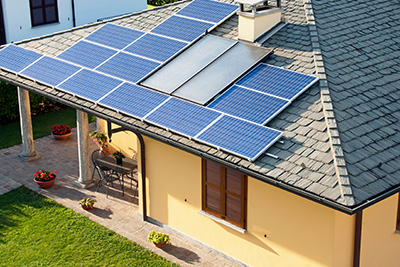
Adding solar panels to your home is a major investment and tends to be a high-involvement purchase. Among the decisions you’ll need to make is how many solar panels to include in your solar array. There’s no one-size-fits-all answer; the ideal number of panels depends on your energy needs, your location and the type of solar panels you’re installing.
Fortunately, you won’t need to make this decision alone. Any solar installer that’s worth hiring should be able to present you with a range of options, including different numbers and configurations of solar panels. Solar installers can also perform calculations to show you how much electricity generation you can expect from each solar array design, as well as how much they can save you on your energy bills.
But if you haven’t chosen a solar installer yet and are looking to do some initial calculations to get a general idea of how many panels you’ll need, there’s a simple formula you can use.
Calculate Solar Power Needs
The first step is to estimate your energy needs. Take a look at your latest energy bill to see how much electricity in kilowatt-hours (kWh) you used in the past month. You should also look for historical data that shows how much electricity you’ve used over time. If you’ve been with the same electricity supplier or utility for at least a year, you should be able to obtain this data either from your bill or your online account.
It’s a good idea to know how much electricity you use in an average month, which you may need to calculate on your own by adding up your kWh consumption for the past 12 months and dividing the total by 12. From there, you can estimate the amount of electricity you use in a day by dividing your monthly average by 30. You should also check the kWh in your highest electricity-consuming month, which is usually in the middle of summer or winter, depending on how you heat and cool your home.
If you reach out to a solar installer for a price estimate, they’re likely to ask for this information, so it’s a good idea to hang onto this data.
Determine Your Sunlight Potential
Once you understand your energy needs, it’s time to estimate your sunlight potential. Solar installers have their own precise technologies for measuring this, but you can easily get a quick estimate by using our solar calculator. It uses Google Earth images to generate data like the amount of available sunlight per year, the surface area available for rooftop solar panel installation, estimated annual energy savings and more.
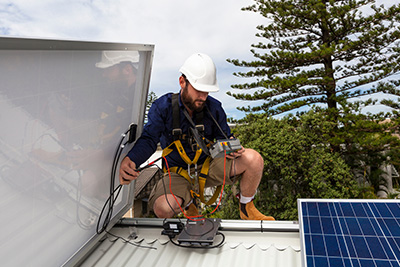
Estimate Solar Panel Efficiency and Output
The last factor to consider is the energy output of the solar panels themselves. There are a few different types of solar panels, including monocrystalline, polycrystalline and thin-film. Monocrystalline solar panels are made from single silicon crystals, which makes them the most efficient of the bunch, but also the most expensive. Polycrystalline solar panels are made by melting down silicon fragments and pouring them into molds, making them cheaper, but slightly less efficient. Most thin-film solar panels are less efficient than polycrystalline, but are typically only used in commercial rooftop installations or situations that demand extremely lightweight panels.
So, how much energy does a solar panel produce? Most residential rooftop solar panels generate somewhere between 250 and 400 watts of electricity during peak sunlight hours. If you want a more specific figure on which to base your calculations, you can reach out to a local solar installer to ask about the output in wattage of the various types of panels they offer.
How Many Solar Panels Does it Take to Power a House?
Now you can complete a rough calculation of the number of solar panels it will take to meet your typical energy needs. Start by multiplying the wattage output of your prospective solar panels – let’s call it 300 watts — by the number of hours of usable sunlight per day. Let’s call that four hours.
300 watts x 4 hours = 1,200 watt-hours
1,200 watt-hours, or 1.2 kWh, is the amount of electricity you can expect to get from a single solar panel in a typical day. To find out how many you will need to power your entire home, take your daily average kWh consumption – let’s call it 30 kWh, which is close to average – and divide it by the kWh of a single panel.
30 kWh / 1.2 kWh = 25
So, using these figures, it would take 25 solar panels to generate the amount of electricity needed to completely offset the average electricity needs of a home.
Talk to the Pros
Keep in mind that you don’t need to completely eliminate your electricity bills to justify an investment in solar. Your home will usually still be connected to the electrical grid, and installing fewer solar panels than the number you calculate can still reduce your monthly bills by a significant amount. You should also remember that since these estimations are based on averages, you will probably use more electricity than you generate on your highest energy consumption days, or when extreme weather forces you to use more electricity than usual.
When you consult with a prospective solar installer about the cost of solar panels, energy outputs and options of your solar installation, you can discuss the number of panels and the implications of increasing or reducing that number. This can affect the size of your potential savings as well as the estimated amount of time it will take for your solar panels to pay for themselves, and you might find that the number of panels that best fits your needs is different from your rough calculation.
Looking for Something Specific?
Select a category to find resources for topics that interest you.
Select Category

Related Articles:
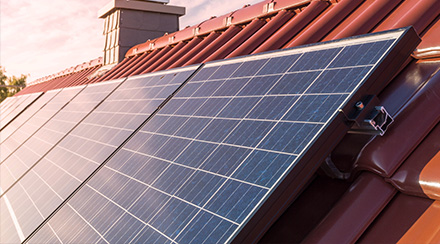
What Is Solar Energy and How Does it Work?
Thanks to rapidly advancing technology, a growing share of our energy comes from renewable sources like wind, hydropower and solar. Learn about solar energy and how it provides for homes and communities.
Read Article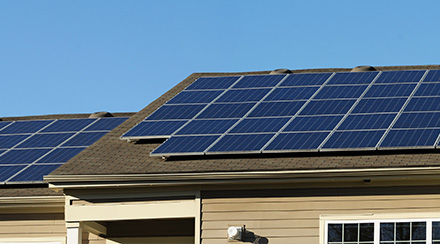
How Do Solar Panels Work?
Rooftop solar panels are among the most visible symbols of a new energy future that is cleaner, healthier and more renewable. But do you know how solar panels work?
Read Article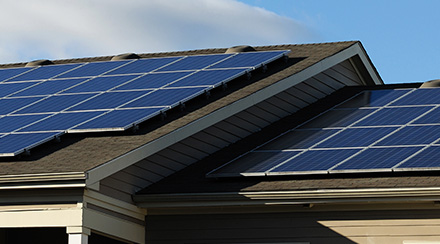
The Different Types of Solar Panels
When deciding what type of solar panel is best for your home, it’s worth taking the time to weigh the pros and cons of each panel type against your budget, climate and energy needs.
Read ArticleHow to Calculate Solar Power Needs for Your Home
Adding solar panels to your home is a major investment and tends to be a high-involvement purchase. Among the decisions you’ll need to make is how many solar panels to include in your solar array. There’s no one-size-fits-all answer; the ideal number of panels depends on your energy needs, your location and the type of solar panels you’re installing.
Fortunately, you won’t need to make this decision alone. Any solar installer that’s worth hiring should be able to present you with a range of options, including different numbers and configurations of solar panels. Solar installers can also perform calculations to show you how much electricity generation you can expect from each solar array design, as well as how much they can save you on your energy bills.
But if you haven’t chosen a solar installer yet and are looking to do some initial calculations to get a general idea of how many panels you’ll need, there’s a simple formula you can use.
Calculate Solar Power Needs
The first step is to estimate your energy needs. Take a look at your latest energy bill to see how much electricity in kilowatt-hours (kWh) you used in the past month. You should also look for historical data that shows how much electricity you’ve used over time. If you’ve been with the same electricity supplier or utility for at least a year, you should be able to obtain this data either from your bill or your online account.
It’s a good idea to know how much electricity you use in an average month, which you may need to calculate on your own by adding up your kWh consumption for the past 12 months and dividing the total by 12. From there, you can estimate the amount of electricity you use in a day by dividing your monthly average by 30. You should also check the kWh in your highest electricity-consuming month, which is usually in the middle of summer or winter, depending on how you heat and cool your home.
If you reach out to a solar installer for a price estimate, they’re likely to ask for this information, so it’s a good idea to hang onto this data.
Determine Your Sunlight Potential
Once you understand your energy needs, it’s time to estimate your sunlight potential. Solar installers have their own precise technologies for measuring this, but you can easily get a quick estimate by using our solar calculator. It uses Google Earth images to generate data like the amount of available sunlight per year, the surface area available for rooftop solar panel installation, estimated annual energy savings and more.
Estimate Solar Panel Efficiency and Output
The last factor to consider is the energy output of the solar panels themselves. There are a few different types of solar panels, including monocrystalline, polycrystalline and thin-film. Monocrystalline solar panels are made from single silicon crystals, which makes them the most efficient of the bunch, but also the most expensive. Polycrystalline solar panels are made by melting down silicon fragments and pouring them into molds, making them cheaper, but slightly less efficient. Most thin-film solar panels are less efficient than polycrystalline, but are typically only used in commercial rooftop installations or situations that demand extremely lightweight panels.
So, how much energy does a solar panel produce? Most residential rooftop solar panels generate somewhere between 250 and 400 watts of electricity during peak sunlight hours. If you want a more specific figure on which to base your calculations, you can reach out to a local solar installer to ask about the output in wattage of the various types of panels they offer.
How Many Solar Panels Does it Take to Power a House?
Now you can complete a rough calculation of the number of solar panels it will take to meet your typical energy needs. Start by multiplying the wattage output of your prospective solar panels – let’s call it 300 watts — by the number of hours of usable sunlight per day. Let’s call that four hours.
300 watts x 4 hours = 1,200 watt-hours
1,200 watt-hours, or 1.2 kWh, is the amount of electricity you can expect to get from a single solar panel in a typical day. To find out how many you will need to power your entire home, take your daily average kWh consumption – let’s call it 30 kWh, which is close to average – and divide it by the kWh of a single panel.
30 kWh / 1.2 kWh = 25
So, using these figures, it would take 25 solar panels to generate the amount of electricity needed to completely offset the average electricity needs of a home.
Talk to the Pros
Keep in mind that you don’t need to completely eliminate your electricity bills to justify an investment in solar. Your home will usually still be connected to the electrical grid, and installing fewer solar panels than the number you calculate can still reduce your monthly bills by a significant amount. You should also remember that since these estimations are based on averages, you will probably use more electricity than you generate on your highest energy consumption days, or when extreme weather forces you to use more electricity than usual.
When you consult with a prospective solar installer about the cost of solar panels, energy outputs and options of your solar installation, you can discuss the number of panels and the implications of increasing or reducing that number. This can affect the size of your potential savings as well as the estimated amount of time it will take for your solar panels to pay for themselves, and you might find that the number of panels that best fits your needs is different from your rough calculation.
Looking for Something Specific?
Select a category to find resources for topics that interest you.
Select Category

Related Articles:

What Is Solar Energy and How Does it Work?
Thanks to rapidly advancing technology, a growing share of our energy comes from renewable sources like wind, hydropower and solar. Learn about solar energy and how it provides for homes and communities.
Read Article
How Do Solar Panels Work?
Rooftop solar panels are among the most visible symbols of a new energy future that is cleaner, healthier and more renewable. But do you know how solar panels work?
Read Article
The Different Types of Solar Panels
When deciding what type of solar panel is best for your home, it’s worth taking the time to weigh the pros and cons of each panel type against your budget, climate and energy needs.
Read Article






